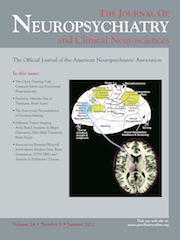Published Online:1 Jul 2012https://doi.org/10.1176/appi.neuropsych.11070157
Metrics
I thank Dr. Yuan-Yu Hsu (Department of Medical Imaging, Buddhist Tzu-Chi General Hospital Taipei Branch) for MRI acquisition help and technical assistance.
History
Published online 1 July 2012
Published in print 1 July 2012



